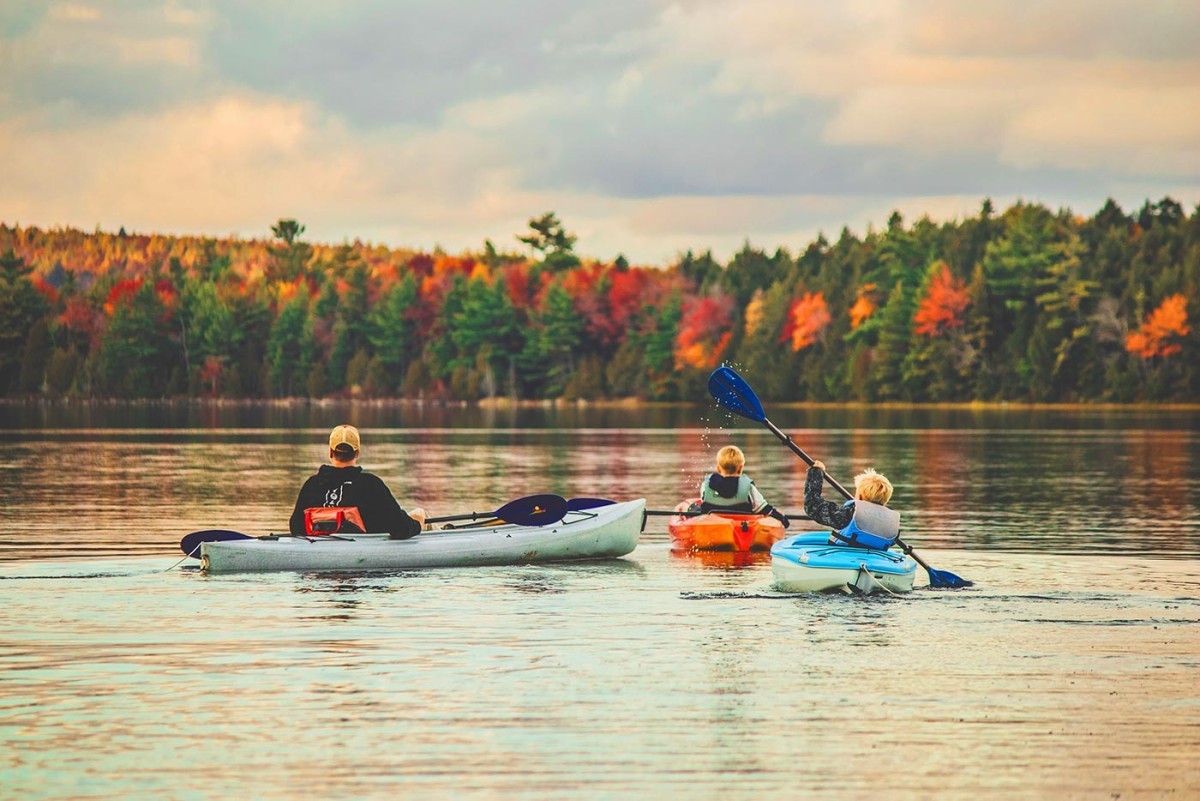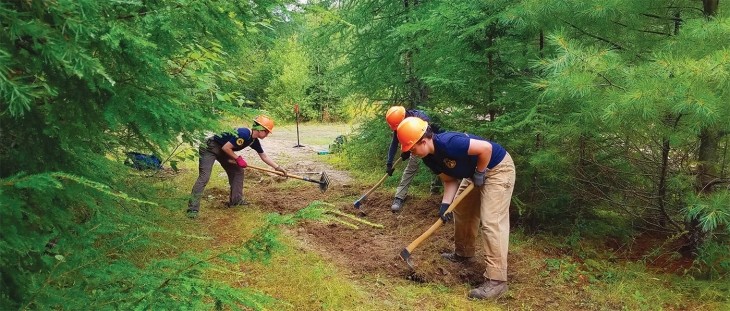An interview with David Montague, president of the Downeast Lakes Land Trust
The Downeast Lakes Land Trust was one of the first organizations in the Northeast to conserve land using carbon sequestration and the sale of carbon credits as a fundraising tool, while meeting their commitment to manage working forests for multiple benefits, including climate resilience. Northern Woodlands recently spoke with David Montague, president of the Downeast Lakes Land Trust, to share his insights. Below are excerpts.
You can learn more about the land trust, including its remarkable origin story, from an audio segment we produced with Erica Heilman as part of our Resilient Forest series.
To start with the basics, a carbon offset – or carbon credit – is a unit of measure for one metric tonne of greenhouse gases that have been sequestered in biomass. In the case of forest carbon, that includes the trees and woody materials of the forest. When you sell a carbon credit, you are agreeing to maintain that sequestered carbon on the land for a certain period of time.
When we first started looking at carbon as an option, we were in the midst of our West Grand Lake Community Forest capital campaign to conserve a large parcel of new land. We needed to raise $19 million to conserve 22,000 acres. We were looking at all different kinds of options for how to raise that money. It was not a very good time financially to launch a capital campaign, as it kicked off in 2008, coinciding with the recession. Carbon appeared to be an opportunity to register credits on the land we already owned, and to sell those to provide revenue for the new project.
The first project was the Farm Cove Carbon Project. That issued credits in 2013. We were able to use revenue from those credits to help purchase the 22,000 acres. But, before closing, we began the second carbon project, which was actually on the acreage that we were seeking to buy. In that case, we were working with the seller of the land and had a revenue split from the carbon project with them. So ultimately when we purchased that property in 2016, it had about $4 million from two different carbon projects factoring into that $19 million purchase price.
Different types of credits are sold on different markets. Some of the most common, and the ones we have worked with most often, are on the California cap-and-trade market, where we sold what are called compliance-grade carbon offsets. Those have a 100-year agreement attached to them. So that means for 100 years, we have to sequester that 100 tonnes of biomass within the project area, which is carefully defined in the agreement.
In the Downeast Lakes Community Forest, three different carbon projects cover different areas, and collectively they now cover virtually the entire community forest. Each of those were developed at different times, and in some cases developed on different markets, but they have all registered and sold carbon credits and we’ve used the revenues from that to conserve additional land.
Some carbon projects encourage deferred harvest, or take lands outside of active management entirely. Our projects and many of the projects in the Northeast are Improved Forest Management projects, the idea being that the forest is being managed above and beyond the standard practice for the region. That’s something that is measured and documented during the project development stage, modeling what the forest would look like under normal business-as-usual management, versus a change in management prompted by the restrictions of a carbon agreement. The difference between those two is what determines the benefit to carbon sequestration and therefore the carbon credits that are developed.
In developing these projects, we worked with individuals who have expertise in developing carbon credits and brokering the sale of credits. They begin with a feasibility study and assessing the amount of carbon that’s currently sequestered on the property, so it’s like doing a timber inventory where you are looking at the tons of timber on a given acreage, but in this case, they are not simply factoring in the merchantable timber, but the branches, the leaves, the root mass – all of it. They are measuring this at a very fine scale, much more precise than the normal timber cruise.
Size of the property is very important. It has to be at least several thousand acres to be feasible, which is one of the challenges for getting into carbon markets for a lot of landowners. Feasibility also depends on how heavily stocked with timber – and therefore carbon – the forest is. The more heavily stocked it is, the more carbon you have the opportunity to sell up front. But, lightly stocked properties are going to generally have a faster growth rate, so they are going to sequester more carbon more rapidly.
Once you have an inventory of the volume of carbon and the number of credits that you think you can sell, this estimate has to be submitted to a third-party verifier. That verifier checks those calculations and then does a spot cruise of the property to check accuracy. Those findings are then submitted to a carbon registry and the registry then checks both the work of the initial developer and the work of the verifier, and determines whether the terms have been met and whether they can issue the credits.
With two of our three projects, the area was fairly well stocked, so we were able to see a significant bump of credits when the project was registered. The third project was different because it was a relatively small parcel – about 6,100 acres – and the previous owner had harvested very heavily, so it was pretty lightly stocked. The carbon project there didn’t result in a large number of credits right off the bat in year one; it was more of an incremental increase over time.
A common misconception when you have a carbon project on a specific acreage is that that means you can’t harvest timber there anymore. That’s not the case. You can still harvest timber on the same acreage; you just have to maintain that minimum biomass stocking. In our case we already have a management plan that’s designed to grow the timber stocks over time, so we’re only harvesting about 50 percent of the timber that is grown in any given year. That means biomass is constantly increasing year to year, and that incentivizes conservative management because it adds a second revenue stream. So there is a revenue stream tied to the timber products harvested off the property, and there is also a dollar value that can be placed on every tree left standing on the stump.
It’s a balancing act between those two forces. It’s still very central to our mission that we continue to harvest timber on all of those same acres, and we are selling those timber products to local mills and employing local contractors for that work. While it would be possible to sell so much carbon on the property that it would no longer be feasible to harvest timber, that was never our goal.
Washington County, where we are located, is the poorest county in Maine and therefore one of the poorest counties in the Northeast. We have close to 60 percent of local students on free or reduced cost lunch programs, and we are in the midst of a federally-recognized rural food desert in which there is low access to healthy food options within a 20-mile radius of many low-income households. Although it is a predominantly white population, we have a large Native American population as well. Our work is really a dual-purpose mission. We are conserving land, but we’re also supporting the local economy. Economic well-being has been part of our core mission ever since our founding, which is fairly uncommon among land trusts or other conservation groups. Whenever we have activities within the community forest it’s always with an eye to benefitting the community in some way, including provision of basic needs like winter heating assistance and accessing traditional foods.
The sale of these carbon credits not only allows us to conserve additional land, but also helps us to pursue other aspects of our mission. We have a lot of outdoor education programming that we do in the community forest and also work in local schools. All of that is free to local participants and free to local students, and that is supported in part through the revenue generated by these carbon-offset sales. All of our lands are open for traditional and motorized recreation, and available to everybody.
The reason that we settled on fee ownership of land rather than holding conservation restrictions relates to our local economy. It’s built on outdoor recreation-based tourism and primarily guiding and sporting lodges, and that really depends on aesthetic beauty, abundant fisheries and wildlife, healthy forest ecosystems, and those things that draw people to the area. We want to have a direct say in how those resources are managed, and that is best accomplished by actually owning the land outright and letting community members decide how management decisions are made, and how habitats and ecosystems are managed. We aren’t just based in the community, we’re led by it.
The community forest is more or less surrounded by Passamaquoddy tribal land. The tribal and non-tribal communities have distinct histories, but there also has been a lot of cultural blending. That definitely has been reflected in the leadership and development of the management style of a lot of our lands. In addition to timber management, we have a number of different use permits that are free for community members to harvest non-timber products in the area. Part of that is driven by economic inputs, but also in recognizing the importance of non-timber products to local crafts that are economically and culturally significant for the Passamaquoddy tribe and others in the area. Activities such as harvesting brown ash for basketmaking, birch bark for various crafts, or sweetgrass for ceremonial purposes. All of that is not only permitted but also encouraged, and it is codified in the management plans and conservation easements for the properties. That is part of our core culture.
Web Extras: Related Content
You can learn more about the Downeast Lakes Land Trust, including its remarkable origin story, in this audio segment we produced with Erica Heilman as part of our Resilient Forest series.



